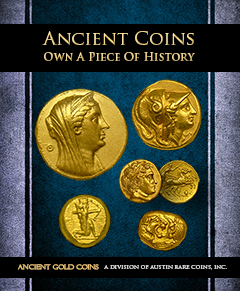Ancient Coin Timeline
Archaic Period - 800-480 B.C.
The dawn of coinage occurred during this period and was integral in fueling commerce and trade. This period of human history saw dramatic population growth and a rapid expansion of commerce. The rise in population brought with it the settlement of new towns along the Mediterranean and Black Sea coastlines. The Archaic Period ended when the Persian King Xerxes invaded Greece in roughly 480 B.C.. Some of the most noteworthy coins of the Archaic Period are listed below:
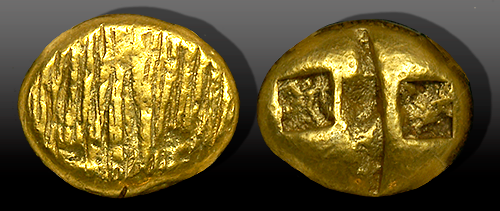 650-600 B.C. (Electrum Ripple)
650-600 B.C. (Electrum Ripple)
Most scholars agree that the advent of coinage occurred at the end of the seventh century B.C. in western Asia Minor (present-day Turkey). The photo below shows a Half-Stater of electrum, a naturally occurring pale yellow mixture of gold and Silver. The obverse of the coin has intricately carved lines, or “ripples”, thought to symbolize running water. The reverse employs an incuse double punch that occurred when the coin was struck so long ago.
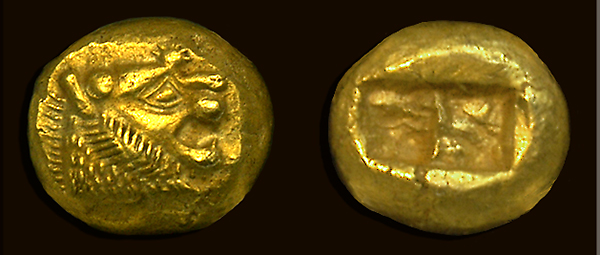 610-565 B.C. (Electrum Coinage of King Alyattes)
610-565 B.C. (Electrum Coinage of King Alyattes)
As coinage became more widespread and accepted, more intricate obverse designs, such as animals, were employed. Coinage continued to be struck using electrum and the example below shows a roaring lion with a rising sun in the background. Electrum continued to be the only metal used in coinage until the process of refining gold and silver was perfected.
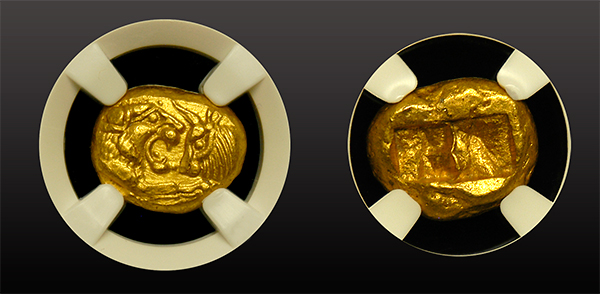 565-546 B.C. (Gold and Silver Coinage of King Croesus
565-546 B.C. (Gold and Silver Coinage of King Croesus
The stunning coinage of Lydian King Croesus represents the first true bimetallic coinage system and the ability to refine and separate electrum into (nearly pure) gold and silver. The stunning design employed on these coins shows a lion and bull, thought to symbolize strength and virility. These amazing coins were struck in several different sizes, or fractions, of a Stater, ranging from a full Stater all the way down to a 1/24th Stater in both gold and silver. Below is a stunning gold Stater certified by NGC in Mint State star condition.
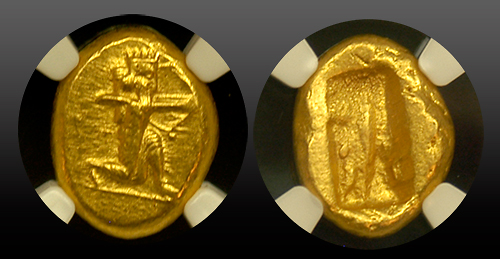 550–330 B.C. (Gold and Silver Coinage of the Achaemenid Empire)
550–330 B.C. (Gold and Silver Coinage of the Achaemenid Empire)
The massive Persian army defeated the Lydian King Croesus and immediately began issuing their own coinage produced with gold and silver from their many conquests. These gold coins, called “darics”, were so named in honor of King Darius, and their silver coinage was referred to as “siglos”. The designs employed were Persian in nature, depicting a “hero-king” in a running/crouching stance with a bow in one hand and a weapon in the other hand such as a spear or knife. The reverse carried the incuse punch that had been employed on all coinage since the beginning.
500-323 B.C. (The Classic Period)
This period of human history greatly influenced the foundations of modern Western Civilization. Today’s political, artistic, architectural, and scientific thought derives from this period of Greek history. The Classical Period ended with the death of Alexander the Great around 323 B.C. and below are some of the more noteworthy and popular coins of the era.
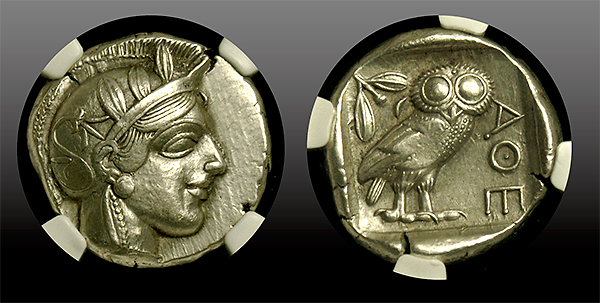 478-407 B.C. (Athenian Silver Owls)
478-407 B.C. (Athenian Silver Owls)
These large Silver coins were produced in large quantities and were widely circulated. They are also one of the more popular Ancient coins available today. Their quality varies widely and those with a bold, well-centered strike on the front and back are extremely desirable. The obverse features Athena, the goddess of wisdom and reason, and her totem bird, the owl, can be found on the reverse.
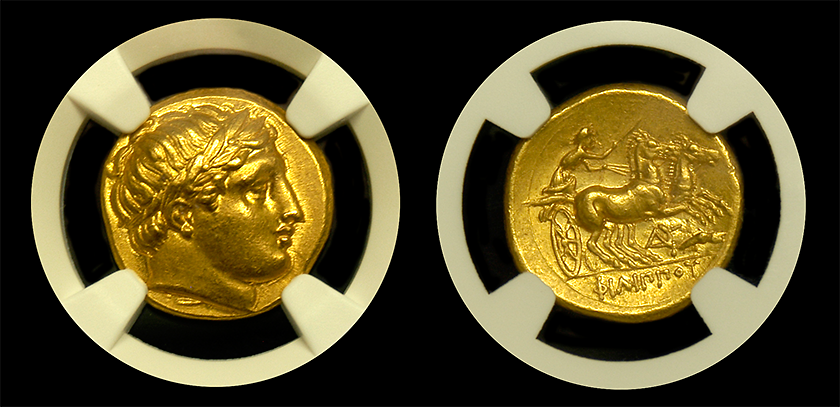 359-323 B.C. (Philip II Gold Stater)
359-323 B.C. (Philip II Gold Stater)
This remarkable and intricate gold coin was issued during and after the reign of Philip II, the father of Alexander the Great. Weighing around ¼ of an ounce, the obverse features the head of Apollo and the reverse shows a charioteer being pulled by two intricately etched horses. There is no question the artist who carved these dies was one of the finest of his time. These coins were not only used as money, but also as propaganda to broadcast across the vast empire to show the people who their great leader was.
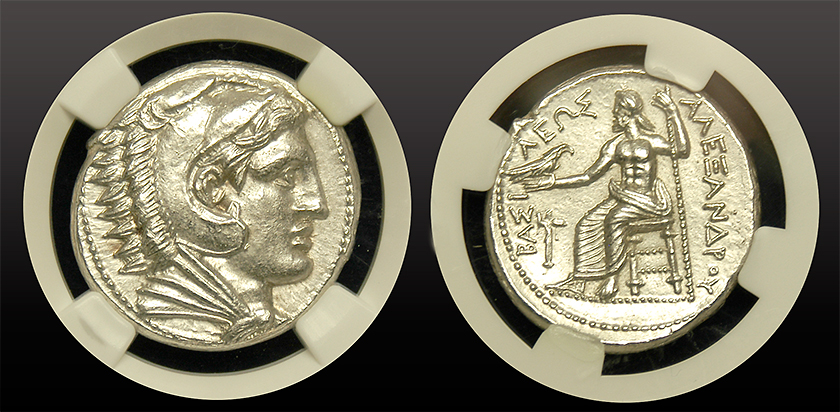 336-323 BC (Alexander the Great Silver Tetradrachm)
336-323 BC (Alexander the Great Silver Tetradrachm)
These hefty silver coins were issued during and after the reign of Alexander the Great and are without question one of the most popular of all Ancients. The obverse depicts the mythical hero Hercules wearing a lion’s scalp and the reverse shows a seated Zeus holding a perched eagle. These coins were issued in large quantities around 2,300 years ago and most known survivors are heavily worn. Lustrous, Mint State examples are in very high demand and are treasured by collectors today.
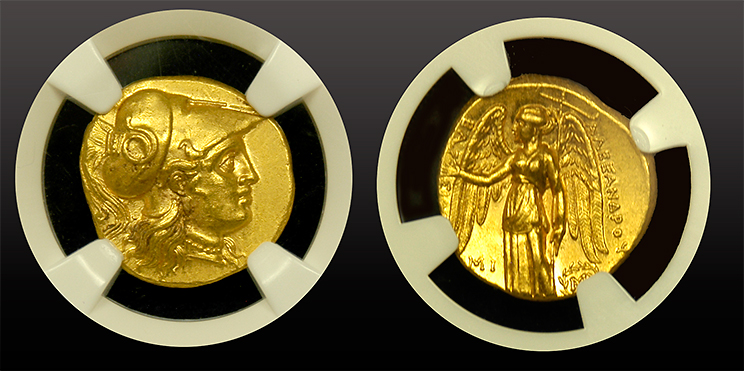 336-323 BC (Alexander the Great Gold Stater)
336-323 BC (Alexander the Great Gold Stater)
The gold coinage issued during and after the reign of Alexander the Great is extremely popular and very desirable in today’s market. Coins preserved in Mint State condition are highly sought after and seldom encountered. The obverse depicts Athena the goddess of war, and the reverse shows Nike, the goddess of victory. These coins were struck and circulated widely across Alexander’s empire and continued to be produced in the few years after his death.
323-146 B.C. (Hellenistic Period)
The Hellenistic Period began when Alexander the Great died in 323 B.C. After his death, the kingdom was divided into three main divisions comprised of Egypt, Asia Minor and Macedonia. Greek influence continued to spread throughout the region and coinage portrayed this rapid evolution. In many instances, portraits of the actual rulers were used, as can be seen below.
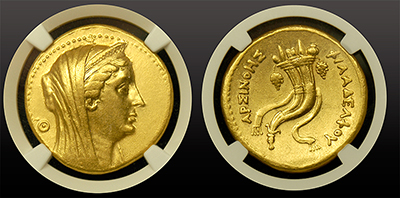 270-221 B.C. (Arsinoe II Gold Octodrachm)
270-221 B.C. (Arsinoe II Gold Octodrachm)
This large, nearly 1 ounce gold coin (pictured below) was struck in Egypt to honor Arsinoe II, sister and wife of Ptolemy II of Egypt. The Ptolemaic Dynasty ruled Egypt for nearly three centuries following the death of Alexander the Great, when one of Alexander’s most trusted generals, Ptolemy I, established control over the area. Nothing broadcasted the great wealth of Egypt like these massive and impressive gold Octodrachms.
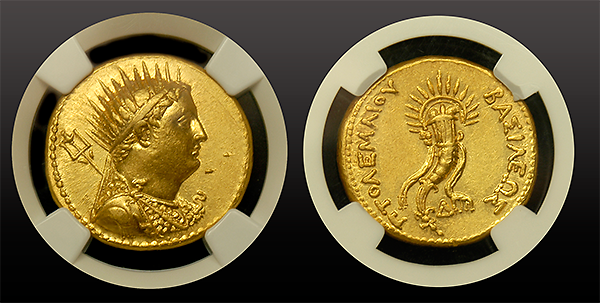 221-205 B.C. (Ptolemy III Gold Octodrachm)
221-205 B.C. (Ptolemy III Gold Octodrachm)
Ptolemy III was the grandson of Ptolemy I, the founder of the Ptolemaic dynasty. Continuing the tradition of large, impressive coinage, this coin was actually struck by Ptolemy IV to honor his deified father. The coin depicts a god-like image of Ptolemy III wearing a golden crown and the reverse depicts a cornucopia.
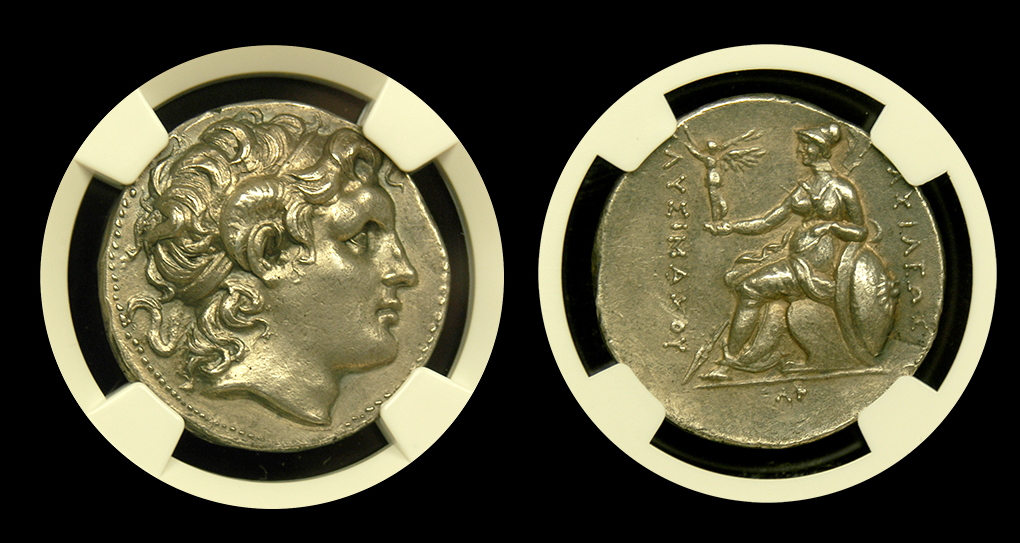 305-281 B.C. (Lysimachus Tetradrachm)
305-281 B.C. (Lysimachus Tetradrachm)
After the death of Alexander the Great in 323 B.C., one of his own personal guards, Lysimachus, was involved in the struggle over the empire. The coinage of Lysimachus pays homage to his fallen leader, as the obverse portrait is thought to have been that of Alexander himself. The reverse shows Athena seated on a throne holding a statuette of Nike, the goddess of Victory. An impressive and lifelike Ancient in all regards.
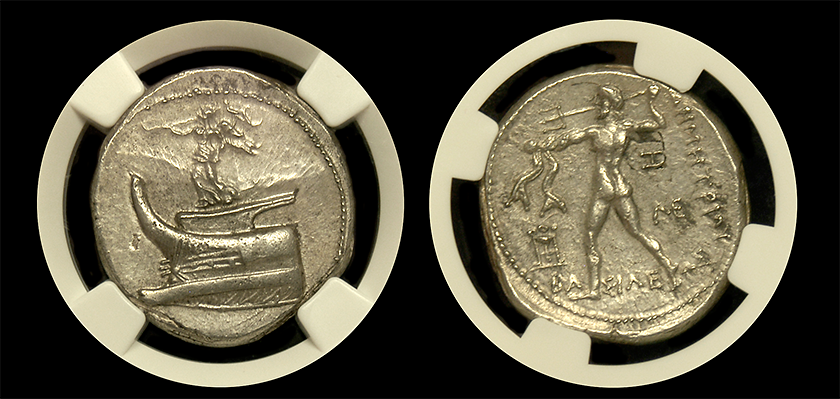 306-283 B.C. (Demetrius Poliorcetes Tetradrachm)
306-283 B.C. (Demetrius Poliorcetes Tetradrachm)
Demetrius was the son of Alexander the Great’s general, Antigonus I Monophthalmus, who fought to claim his empire. He came very close to doing so. His coinage, much like his life, was notable for its originality. The obverse of the coin features Nike, the goddess of Victory, on the front of a ship blowing a trumpet and holding a naval standard, the symbol of victory. The reverse is magnificent, depicting Poseidon wielding a trident, as seen from the back.
146-30 B.C. (Post-Hellenistic Period)
120-63 B.C. In the 2nd to 1st centuries BC, Rome conquered Greece piece by piece until, with the conquest of Egypt in 30 BC, the Roman Empire controlled the Mediterranean. Roman art and literature were imposed upon Hellenistic models.
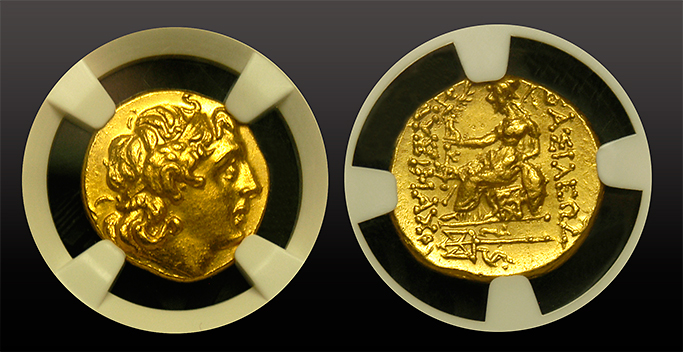 (Mithradates VI Gold Stater)
(Mithradates VI Gold Stater)
There were three wars between Rome and the kingdom of Pontus in the 1st Century B.C., called the Mithridatic Wars. So named in honor of Mithridates VI, the wars ended around 63 B.C. when Roman armies finally defeated the Kingdom of Pontus. This coinage was issued to honor the memory of Alexander the Great, as it was thought his portrait graced the obverse of this coin. Athena, the goddess of war is found on the reverse
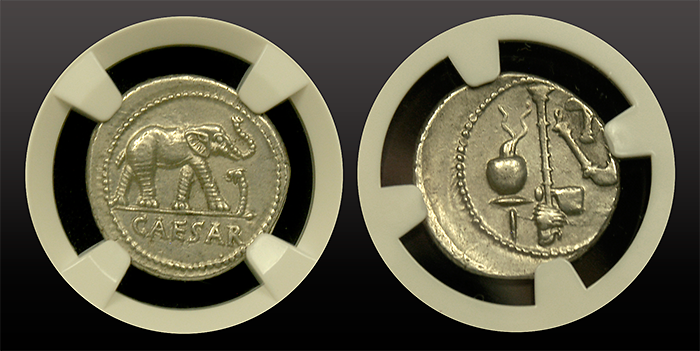 49-48 B.C. (Julius Caesar Silver Denarius)
49-48 B.C. (Julius Caesar Silver Denarius)
This silver coin was issued during the reign of Julius Caesar and depicts and elephant trampling a serpent, thought to symbolize the Roman Empire defeating the Greek dissidents. Coinage of this era depicted events and issues of the time and it’s clear to see the message the Romans were sending out to their enemies.
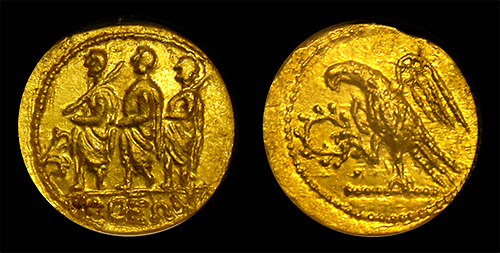 44-42 B.C. (Roman Gold Stater of Brutus)
44-42 B.C. (Roman Gold Stater of Brutus)
It is believed that these Brutus gold Staters were issued to help pay mercenaries in Brutus’ army in the Roman Civil Wars that followed the murder of Julius Caesar. The obverse depicts a Roman consul accompanied by two lictors (body guards) and the reverse has a heraldic eagle standing on a scepter holding a wreath in its talon. Weighing over 8 grams this is a memorable coin with extraordinary detail and historical significance.
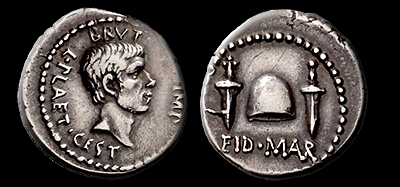 42 B.C. (Brutus “Eid Mar” Denarius)
42 B.C. (Brutus “Eid Mar” Denarius)
This coin is rated #1 of the 100 Greatest Ancient Coins, written by Harlan J. Beck. It was struck to commemorate the assassination of Julius Caesar and is consider one of the rarest coins in existence today. The obverse features Brutus’s portrait, one of Caesar’s assassins, with the legend BRVT IMP L PLAET CEST, which means Brutus, Imperator, Lucius Plaetorius Cestianus. The reverse has a liberty cap with two daggers and the words EID MAR meaning “Eidibus Martiis” or “the Ides of March.” The message was meant to convey that on the Ides of March, Brutus set the Romans free.

